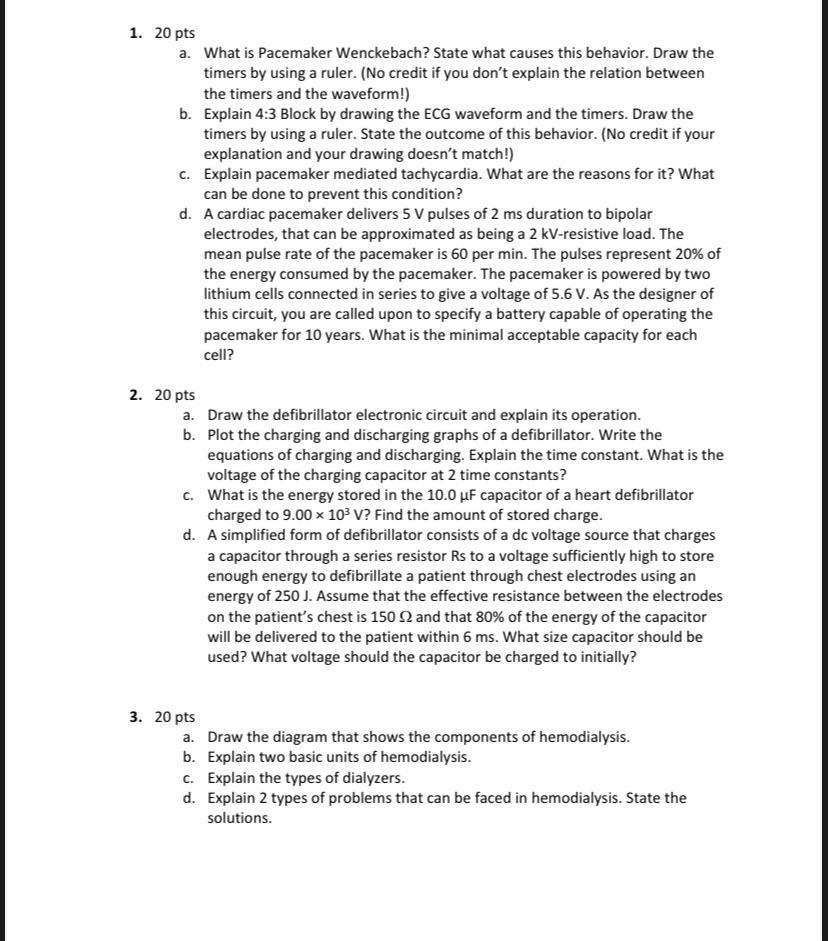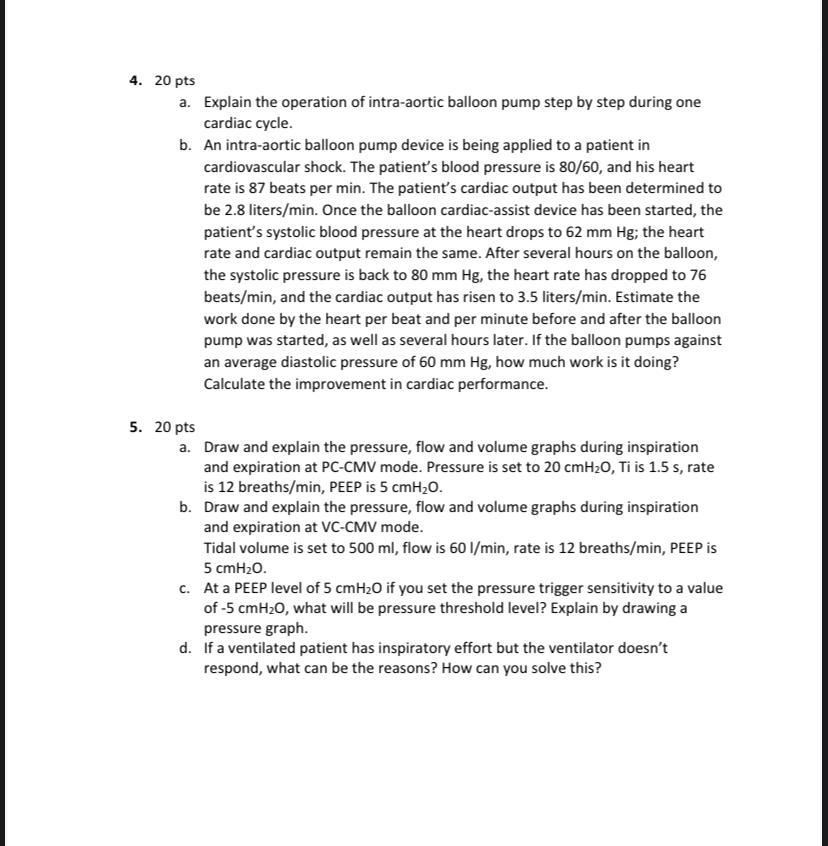Home /
Expert Answers /
Electrical Engineering /
1-20-pts-a-what-is-pacemaker-wenckebach-state-what-causes-this-behavior-draw-the-timers-by-usi-pa882
(Solved): 1. 20 pts a. What is Pacemaker Wenckebach? State what causes this behavior. Draw the timers by usi ...
1. 20 pts a. What is Pacemaker Wenckebach? State what causes this behavior. Draw the timers by using a ruler. (No credit if you don't explain the relation between the timers and the waveform!) b. Explain 4:3 Block by drawing the ECG waveform and the timers. Draw the timers by using a ruler. State the outcome of this behavior. (No credit if your explanation and your drawing doesn't match!) c. Explain pacemaker mediated tachycardia. What are the reasons for it? What can be done to prevent this condition? d. A cardiac pacemaker delivers 5 V pulses of 2 ms duration to bipolar electrodes, that can be approximated as being a 2 kV-resistive load. The mean pulse rate of the pacemaker is 60 per min. The pulses represent 20% of the energy consumed by the pacemaker. The pacemaker is powered by two lithium cells connected in series to give a voltage of 5.6 V. As the designer of this circuit, you are called upon to specify a battery capable of operating the pacemaker for 10 years. What is the minimal acceptable capacity for each cell? b. a. Draw the defibrillator electronic circuit and explain its operation. Plot the charging and discharging graphs of a defibrillator. Write the equations of charging and discharging. Explain the time constant. What is the voltage of the charging capacitor at 2 time constants? c. What is the energy stored in the 10.0 ?F capacitor of a heart defibrillator charged to 9.00 x 10³ V? Find the amount of stored charge. d. A simplified form of defibrillator consists of a dc voltage source that charges a capacitor through a series resistor Rs to a voltage sufficiently high to store enough energy to defibrillate a patient through chest electrodes using an energy of 250 J. Assume that the effective resistance between the electrodes on the patient's chest is 150 52 and that 80% of the energy of the capacitor will be delivered to the patient within 6 ms. What size capacitor should be used? What voltage should the capacitor be charged to initially? 3. 20 pts a. Draw the diagram that shows the components of hemodialysis. b. Explain two basic units of hemodialysis. c. Explain the types of dialyzers. d. Explain 2 types of problems that can be faced in hemodialysis. State the solutions. 2. 20 pts
4. 20 pts a. Explain the operation of intra-aortic balloon pump step by step during one cardiac cycle. b. An intra-aortic balloon pump device is being applied to a patient in cardiovascular shock. The patient's blood pressure is 80/60, and his heart rate is 87 beats per min. The patient's cardiac output has been determined to be 2.8 liters/min. Once the balloon cardiac-assist device has been started, the patient's systolic blood pressure at the heart drops to 62 mm Hg; the heart rate and cardiac output remain the same. After several hours on the balloon, the systolic pressure is back to 80 mm Hg, the heart rate has dropped to 76 beats/min, and the cardiac output has risen to 3.5 liters/min. Estimate the work done by the heart per beat and per minute before and after the balloon pump was started, as well as several hours later. If the balloon pumps against an average diastolic pressure of 60 mm Hg, how much work is it doing? Calculate the improvement in cardiac performance. 5. 20 pts a. Draw and explain the pressure, flow and volume graphs during inspiration and expiration at PC-CMV mode. Pressure is set to 20 cmH?O, Ti is 1.5 s, rate is 12 breaths/min, PEEP is 5 cmH?O. b. Draw and explain the pressure, flow and volume graphs during inspiration and expiration at VC-CMV mode. Tidal volume is set to 500 ml, flow is 60 l/min, rate is 12 breaths/min, PEEP is 5 cmH?O. c. At a PEEP level of 5 cmH?O if you set the pressure trigger sensitivity to a value of -5 cmH?O, what will be pressure threshold level? Explain by drawing a pressure graph. d. If a ventilated patient has inspiratory effort but the ventilator doesn't respond, what can be the reasons? How can you solve this?
Expert Answer
Q2) a) Above figure shows a defibrillator. When the switch is in position 1, direct current (DC) from the power supply is applied to the capacitor. Electrons flow from the upper plate to the positive terminal of the power supply and from the negative

